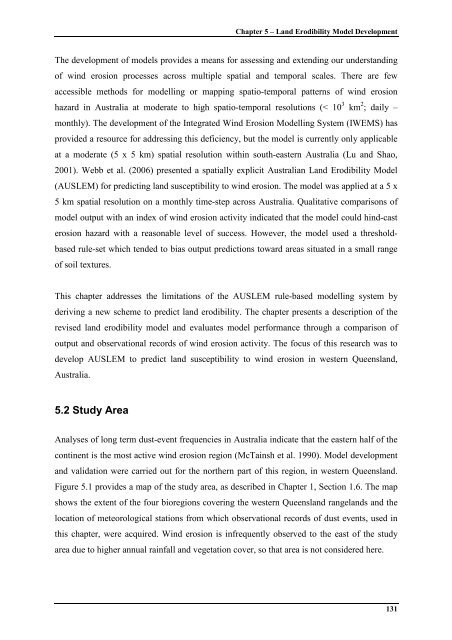Wind Erosion in Western Queensland Australia
Modelling Land Susceptibility to Wind Erosion in Western ... - Ninti One
Modelling Land Susceptibility to Wind Erosion in Western ... - Ninti One
Create successful ePaper yourself
Turn your PDF publications into a flip-book with our unique Google optimized e-Paper software.
Chapter 5 – Land Erodibility Model DevelopmentThe development of models provides a means for assess<strong>in</strong>g and extend<strong>in</strong>g our understand<strong>in</strong>gof w<strong>in</strong>d erosion processes across multiple spatial and temporal scales. There are fewaccessible methods for modell<strong>in</strong>g or mapp<strong>in</strong>g spatio-temporal patterns of w<strong>in</strong>d erosionhazard <strong>in</strong> <strong>Australia</strong> at moderate to high spatio-temporal resolutions (< 10 3 km 2 ; daily –monthly). The development of the Integrated <strong>W<strong>in</strong>d</strong> <strong>Erosion</strong> Modell<strong>in</strong>g System (IWEMS) hasprovided a resource for address<strong>in</strong>g this deficiency, but the model is currently only applicableat a moderate (5 x 5 km) spatial resolution with<strong>in</strong> south-eastern <strong>Australia</strong> (Lu and Shao,2001). Webb et al. (2006) presented a spatially explicit <strong>Australia</strong>n Land Erodibility Model(AUSLEM) for predict<strong>in</strong>g land susceptibility to w<strong>in</strong>d erosion. The model was applied at a 5 x5 km spatial resolution on a monthly time-step across <strong>Australia</strong>. Qualitative comparisons ofmodel output with an <strong>in</strong>dex of w<strong>in</strong>d erosion activity <strong>in</strong>dicated that the model could h<strong>in</strong>d-casterosion hazard with a reasonable level of success. However, the model used a thresholdbasedrule-set which tended to bias output predictions toward areas situated <strong>in</strong> a small rangeof soil textures.This chapter addresses the limitations of the AUSLEM rule-based modell<strong>in</strong>g system byderiv<strong>in</strong>g a new scheme to predict land erodibility. The chapter presents a description of therevised land erodibility model and evaluates model performance through a comparison ofoutput and observational records of w<strong>in</strong>d erosion activity. The focus of this research was todevelop AUSLEM to predict land susceptibility to w<strong>in</strong>d erosion <strong>in</strong> western <strong>Queensland</strong>,<strong>Australia</strong>.5.2 Study AreaAnalyses of long term dust-event frequencies <strong>in</strong> <strong>Australia</strong> <strong>in</strong>dicate that the eastern half of thecont<strong>in</strong>ent is the most active w<strong>in</strong>d erosion region (McTa<strong>in</strong>sh et al. 1990). Model developmentand validation were carried out for the northern part of this region, <strong>in</strong> western <strong>Queensland</strong>.Figure 5.1 provides a map of the study area, as described <strong>in</strong> Chapter 1, Section 1.6. The mapshows the extent of the four bioregions cover<strong>in</strong>g the western <strong>Queensland</strong> rangelands and thelocation of meteorological stations from which observational records of dust events, used <strong>in</strong>this chapter, were acquired. <strong>W<strong>in</strong>d</strong> erosion is <strong>in</strong>frequently observed to the east of the studyarea due to higher annual ra<strong>in</strong>fall and vegetation cover, so that area is not considered here.131
















